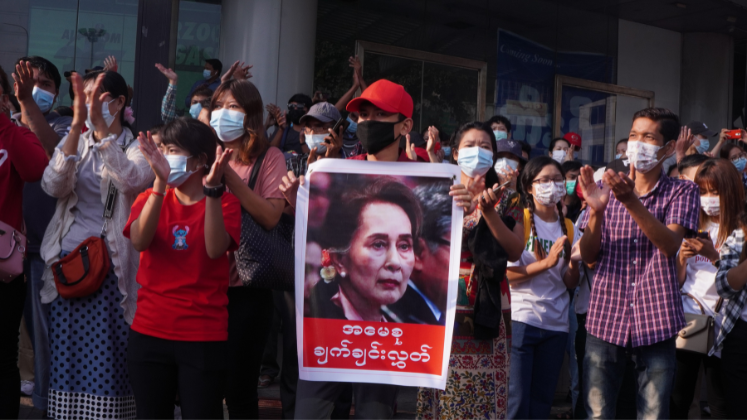In Narrating Democracy in Myanmar: The Struggle between Activists, Democratic Leaders and Aid Workers, Tamas Wells explores the multifaceted ways in which democracy has been conceptualised in Myanmar over the past decade, often outside of a Western liberal democratic paradigm. One year after the military coup, this book still offers an insightful window into the dynamism and contradictions of contemporary Burmese political thought, writes Giulia Garbagni.
This book review is published by the LSE Southeast Asia blog and LSE Review of Books blog as part of a collaborative series focusing on timely and important social science books from and about Southeast Asia.
Narrating Democracy in Myanmar: The Struggle between Activists, Democratic Leaders and Aid Workers. Tamas Wells. Amsterdam University Press. 2021.
 It has been little over a year since the Burmese armed forces (known as Tatmadaw) have seized power in Myanmar, rejecting the electoral victory of the National League for Democracy (NLD) led by Aung San Suu Kyi. It might thus seem ill-timed for researchers to discuss the subtleties of the conceptualisation of democracy in contemporary Myanmar when the country’s democratic experiment has been brought to such a brutal halt. As a work that sets out to do precisely that, however, Tamas Wells’s Narrating Democracy in Myanmar: The Struggle between Activists, Democratic Leaders and Aid Workers proves that, even under the current circumstances, interrogating what the Burmese mean by ‘democracy’ is paramount to understanding what is at stake in Myanmar.
It has been little over a year since the Burmese armed forces (known as Tatmadaw) have seized power in Myanmar, rejecting the electoral victory of the National League for Democracy (NLD) led by Aung San Suu Kyi. It might thus seem ill-timed for researchers to discuss the subtleties of the conceptualisation of democracy in contemporary Myanmar when the country’s democratic experiment has been brought to such a brutal halt. As a work that sets out to do precisely that, however, Tamas Wells’s Narrating Democracy in Myanmar: The Struggle between Activists, Democratic Leaders and Aid Workers proves that, even under the current circumstances, interrogating what the Burmese mean by ‘democracy’ is paramount to understanding what is at stake in Myanmar.
Based on over 65 interviews with foreign aid workers, Burmese democracy activists and NLD political figures conducted between 2015 and 2018, and building on the author’s own professional experience in the NGO sector in Myanmar from 2006 to 2012, Narrating Democracy in Myanmar offers a sweeping overview of the multifaceted ways in which ‘democracy’ has been imagined, narrated and leveraged politically by different agents involved in the country’s democratisation process over the past decade.
Wells’s fundamental premise is a staunchly anti-positivist one: rejecting the idea that democracy can be measured scientifically according to a ‘minimum definition’, he takes issue with any attempts to ascribe it to a universal ‘ideal type’ which, he notes, invariably coincides with the yardstick of Western-style ‘liberal democracy’, against which Myanmar’s institutions are bound to be found lacking. Resisting the urge to assume that democratisation only moves along the axis of liberal democracy is, Wells argues, necessary for appreciating that actors and institutions that deviate from the liberal model championed by OECD donors might be simply ‘playing different games’ (199).
This ‘game’ has deep roots. After a densely theoretical Chapter Two, in Chapter Three Wells illustrates how discourses of ‘democracy’ not only originated in the colonial period, but were also defined by different interpretations of Myanmar’s precolonial past. Against the ‘white man’s burden’ narrative that framed British rule as a duty to steer the ‘immature’ Burma away from oriental despotism and towards a Western-sponsored ‘ocean of democracy’, the nationalist Anti-Fascist People’s Freedom League (AFPFL) instead emphasised the democratic nature of the Burmese monarchy, pointing to the existence of checks and balances (a parliament and a powerful monastical clergy), as well as to Buddhist traditions of grassroots self-rule, as evidence of the innate democratic qualities of Burmese traditional culture and society.
Parliamentary democracy in Myanmar did not survive the ethnic civil war that followed independence in 1948, giving way to military dictatorship. Yet, as described in Chapter Four, not even the generals resisted the temptation to forge their own brand of ‘democratic’ governance – that of ‘disciplined democracy’ – to justify the army’s role as the guarantor of the nation’s integrity.

Image Credit: Photo by Saw Wunna on Unsplash
After sketching this historical background, Wells dedicates each of the book’s core chapters (Chapter Five, Six and Seven) to what he identifies as the three distinct, but at times overlapping, narratives of democracy that have coexisted in Myanmar’s recent democratisation. Accordingly, these are the ‘liberal narrative’ of OECD donors, which defines democratisation as institutionalisation; the ‘benevolent narrative’ of the NLD, which espouses a moral vision of democracy whereby democratic leadership rests on individual selflessness and devotion to unity; and the ‘equality narrative’ of Burmese activists and intellectuals, which calls for secularism and inclusivity.
Each of these actors identifies the crux of Myanmar’s problems in different things: Western donors point to the persistence of military/civil, ethnic and religious cleavages, as well as a personalised political culture that devalues formal processes; the NLD to the lack of moral discipline and unity within the democratic movement itself; activists to those hierarchical relations of power in Burmese politics and society that leave little room for minoritarian views or dissenting opinions. Unsurprisingly, each narrative also strengthens the self-assigned role of their proponent: international agencies as the only qualified supervisors of ‘capacity-building’ projects; the NLD and Aung San Suu Kyi as the only credible moral leader for the country; intellectuals and activists as the only effective driver of cultural change against the ‘one lady show’ of Aung San Suu Kyi (154).
Wells’s examination of the ‘benevolent’ understanding of democracy in Chapter Six stands out as particularly insightful as it sheds light on a puzzle encountered by many foreign observers: why has the NLD been less receptive to the recommendations of Western advisors than the previous military regime? While the Tatmadaw welcomed any form of institutional strengthening, including from Western-sponsored ‘capacity-building’ initiatives, the NLD – and its electoral base – espouses a vision of democracy rooted in Buddhist thought, whereby good governance does not rest on a procedural system, but rather on the ‘benevolence’ or ‘goodwill’ (in Burmese, sedana) of the ruler.
Democracy, accordingly, depends on the individual’s ability to transcend their innate selfishness, and the failure to do so will produce the moral degeneration of ‘ar nar shin’: a dictator wielding power for their own self-interest. The surest way for ensuring the moral rectitude of both rulers and ruled is ‘si kan’, ‘discipline’, in observance to a rigidly hierarchical view of democratic duties that mirrors traditional social obligations. Concretely, this narrative translates into extreme deference to the party’s leadership, with paradoxical results: in ‘discussion meetings’, Wells observed NDL politicians casting their unanimous vote on a motion before sitting through hours of discussion on it (183).
In the examination of all of these narratives, the issue of ethnic minorities – all victims, to varying degrees, of state-sponsored violence since independence – inevitably lingers in the background. Wells, whose interviews involved only urban interlocutors from the Bamar ethnic majority, openly acknowledges the limitations of his pool of interviewees and caveats against drawing blanket conclusions for the entirety of Burmese society from his study. Yet, while his reticence on this point might be justifiable on methodological grounds, it still leaves unanswered an inescapable question when we talk of democracy in a country where roughly 40 per cent of the population belongs to ethnic and religious minorities: who gets to exercise it?
Wells tends to boil down Aung San Suu Kyi and the NLD’s shocking insensitivity towards the violence against the Muslim Rohingya community to the rejection of liberal democratic principles and universal values, including ‘human rights’, among both the Burmese ruling elite and mainstream public opinion – echoing his argument that activists and leaders in young democracies do not necessarily subscribe to liberal-democratic tenets. Wells does make passing mentions of a deeper level of analysis, for instance of Matthew Walton’s leading scholarship on political Buddhism. However, he avoids questioning how the NLD’s insistence on Buddhist precepts relates to the fundamental issue of democratic representation, leaving unaddressed more complex issues of national identity, sovereignty and citizenship. These, as brilliantly illustrated by Thant Myint-U, range from the ethno-nationalist roots of modern Myanmar’s constitutional set-up to the nativist ideals of cultural homogeneity informing the NLD’s political platform, and they ultimately determine who belongs and who does not in Myanmar – that is, who has the right to partake in its democracy, however conceptualised and narrated.
All in all, Narrating Democracy in Myanmar represents a valuable complement to the literature on contemporary Burmese political thought and democracy in Myanmar, one that gives a welcome judgement-free space to a gamut of diverse, often conflicting, perspectives on the ground. It certainly leaves the reader with the hope that Burmese activists, intellectuals, politicians and civilians can soon recover their right to imagine, debate and pursue what democracy means for them.
Note: This review gives the views of the author, and not the position of the LSE Review of Books blog, LSE SEAC blog nor of the London School of Economics and Political Science.







